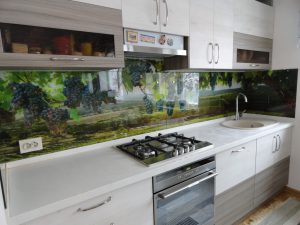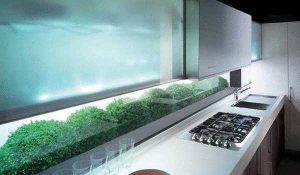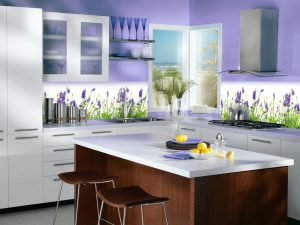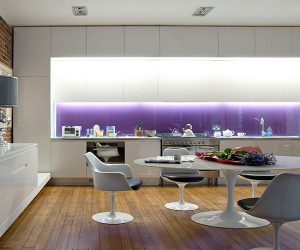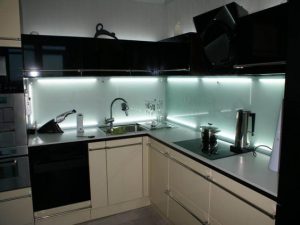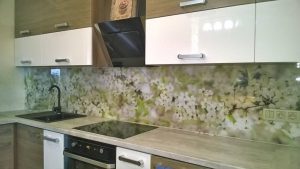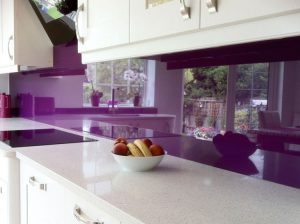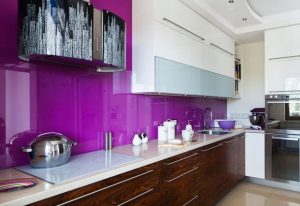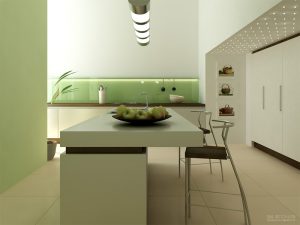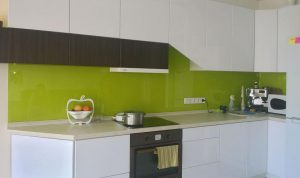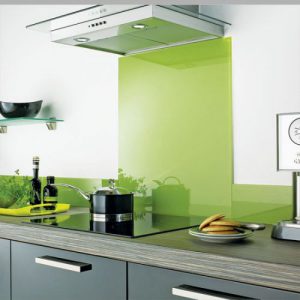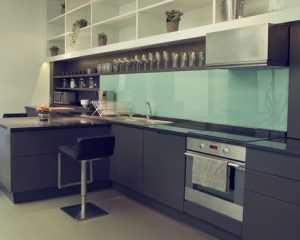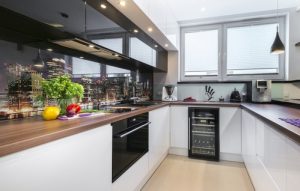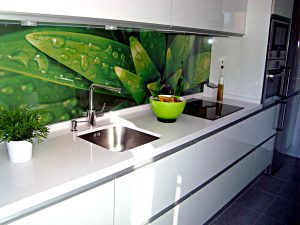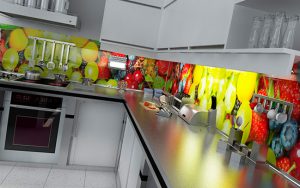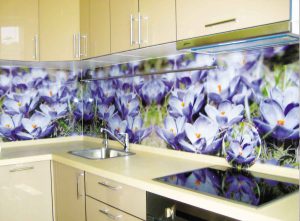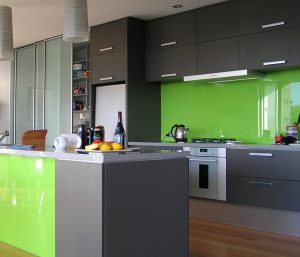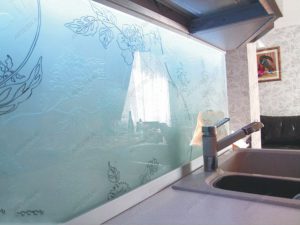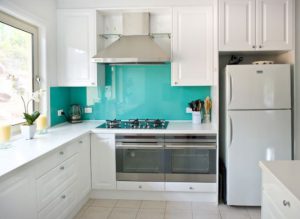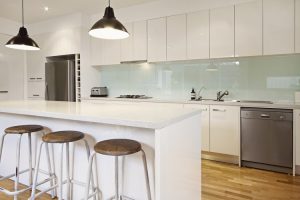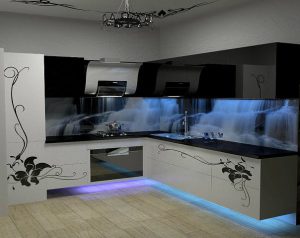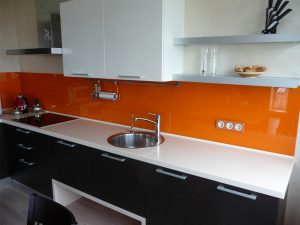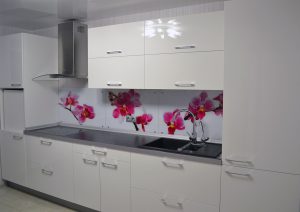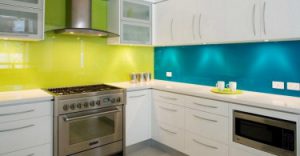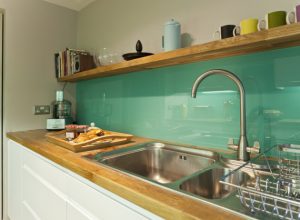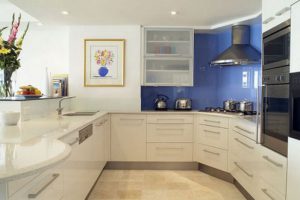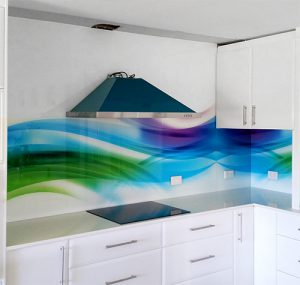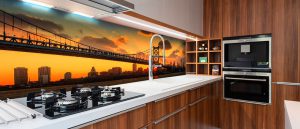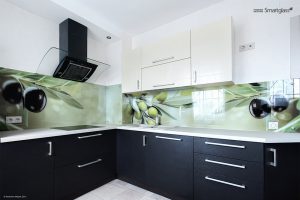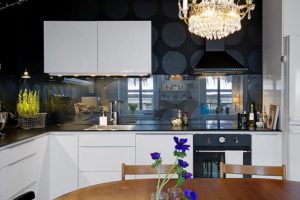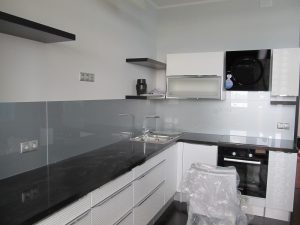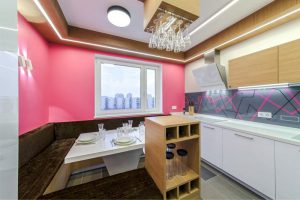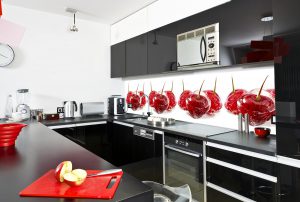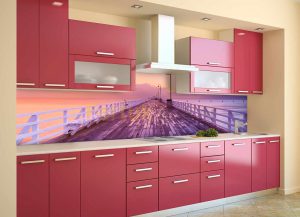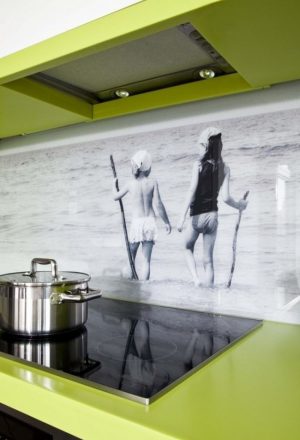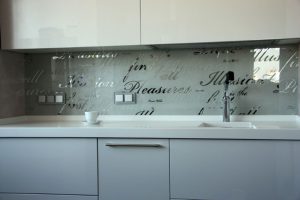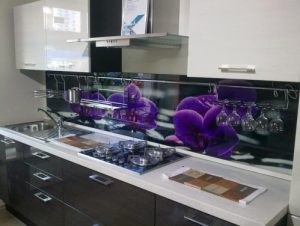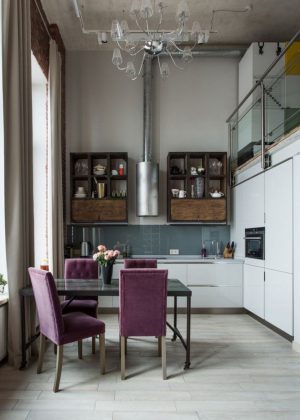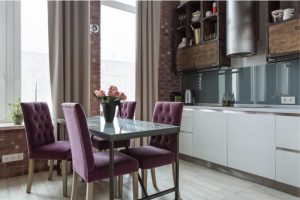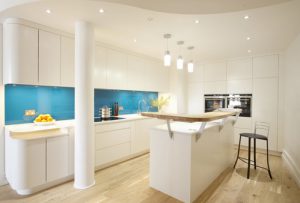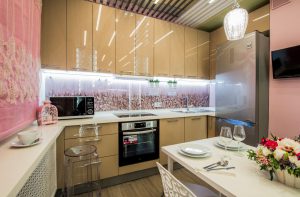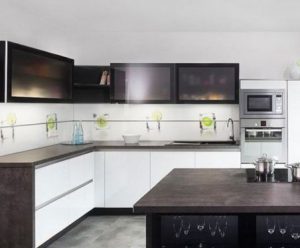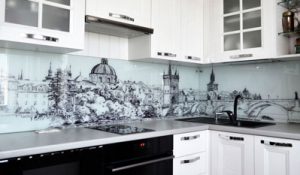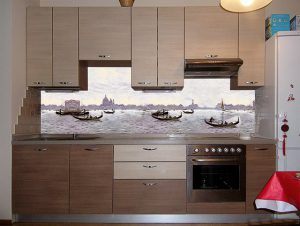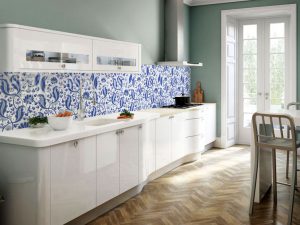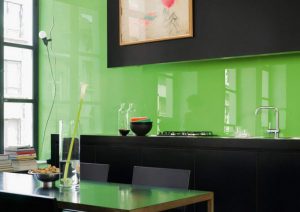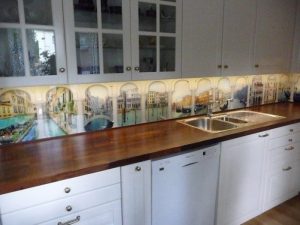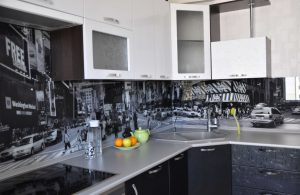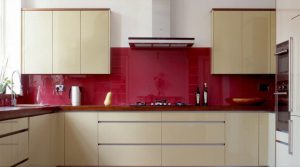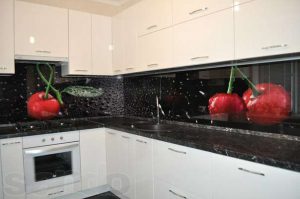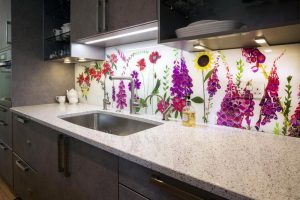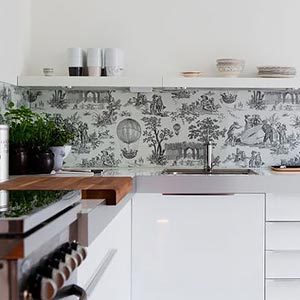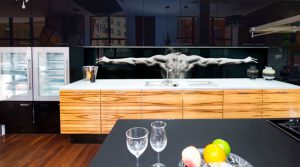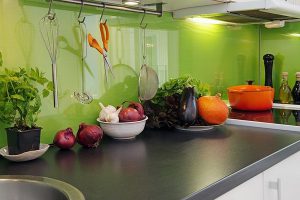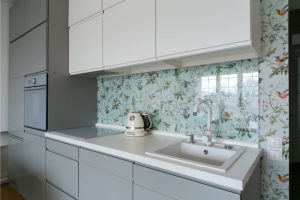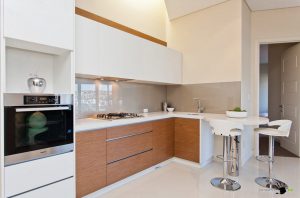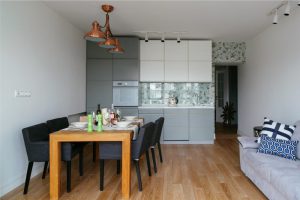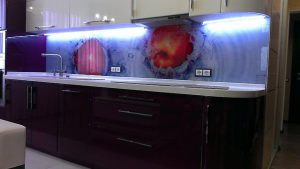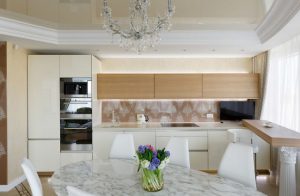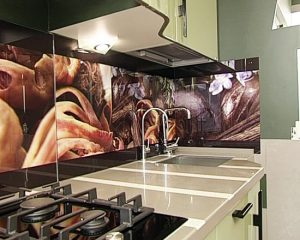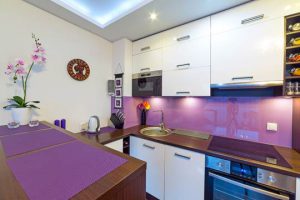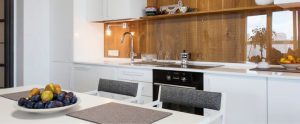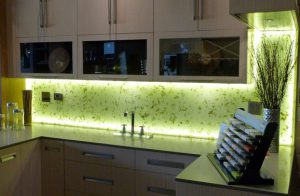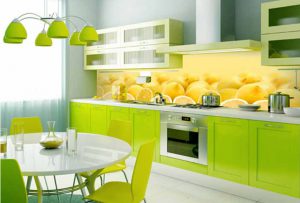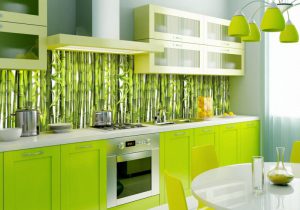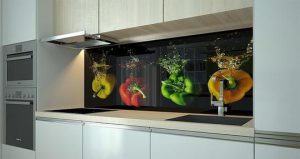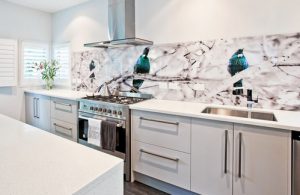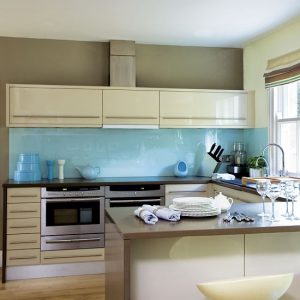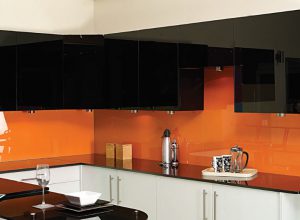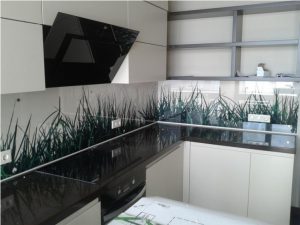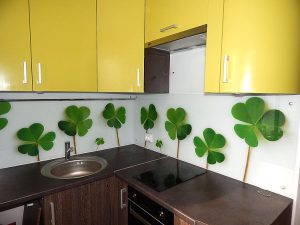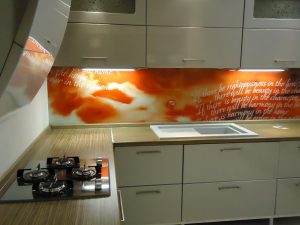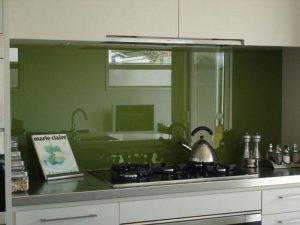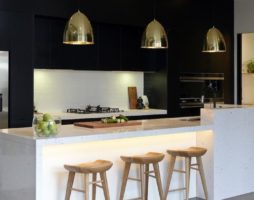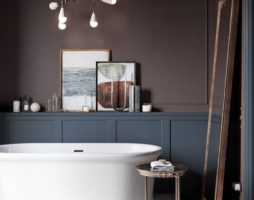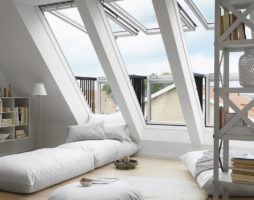The appearance of the skinali made it possible to reconsider approaches to the design of the kitchen interior. A glass kitchen apron has not only become a popular interior solution, it has managed to dislodge from the decorative Olympus, it would seem, the eternal kitchen inhabitant - ceramic tiles.
- Glass apron in the kitchen: pros and cons
- Not all glass is suitable for an apron
- How to make a glass apron
- Glass kitchen apron: installation subtleties
- Illuminated glass kitchen apron
- Dimensions of the glass apron
- How much does a glass apron cost
- Let's summarize the information
- Conclusion
- Photo gallery - glass kitchen apron
- Video
Why did this innovation so appeal to designers and apartment owners? How to choose the right glass decor for a particular setting? What information about the material you need to have in order to avoid disappointment? This will be discussed further.
Glass apron in the kitchen: pros and cons
"An apron for a kitchen made of glass is the easiest way to decorate its interior and emphasize the individuality of the situation"
Compared to wall tiles, skinali looks much more spectacular. Glass panels are characterized by:
1. Hygiene;
2. Decorative variety;
3. Easy installation;
4. Strength;
5. Durability;
6. Operational safety.
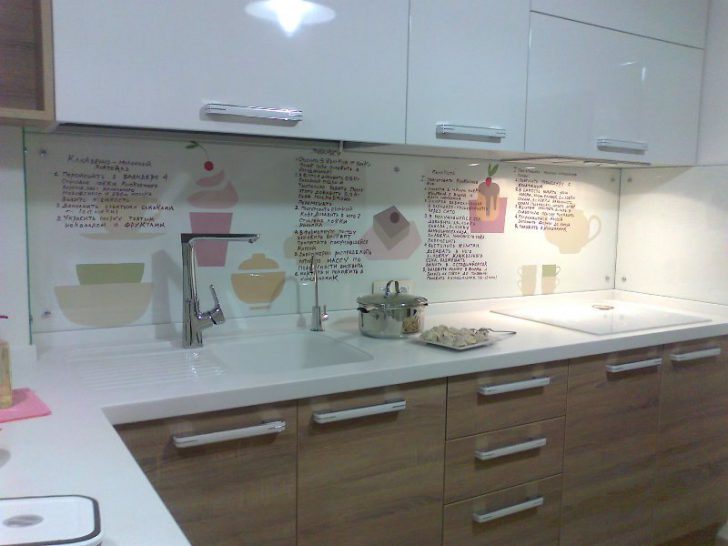
Glass kitchen apron looks spectacular
The first is ensured by the absence of grouts and various irregularities, that is, places where dirt likes to accumulate. The second is the unlimited choice of design options. Any pattern can be applied to the panel. It can also be painted in a suitable color. Whatever the finish, it will never lose its attractiveness (it will not burn out, it will not be erased, it will not be washed off). And yet, the glossy surface of the apron will be involved in adjusting the kitchen space, which will greatly help to properly arrange small rooms.
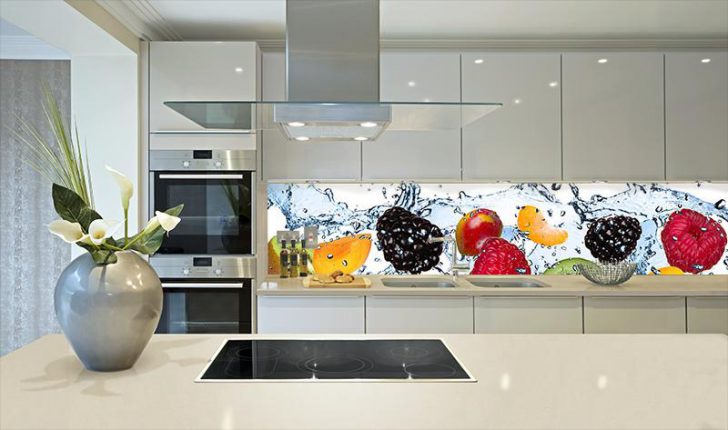
Any pattern can be applied to a glass apron
An apron for a kitchen made of glass is the easiest way to decorate its interior and emphasize the individuality of the situation.
There is only one drawback to such a design element: durable glass cannot be cut at home, which does not allow you to adjust its configuration, as well as make additional holes, for example, to remove sockets.
back to index ↑Not all glass is suitable for an apron
Glass 6 - 8 mm thick, which has undergone special processing, can serve as a material for creating a skinali. In the working area, only its tempered version should be used, since it fully complies with safety requirements and can actually be a durable and reliable coating. The strength of such glass is 5 times higher than that of ordinary glass. Even if you manage to break it, the panel will crumble into small and non-sharp fragments.
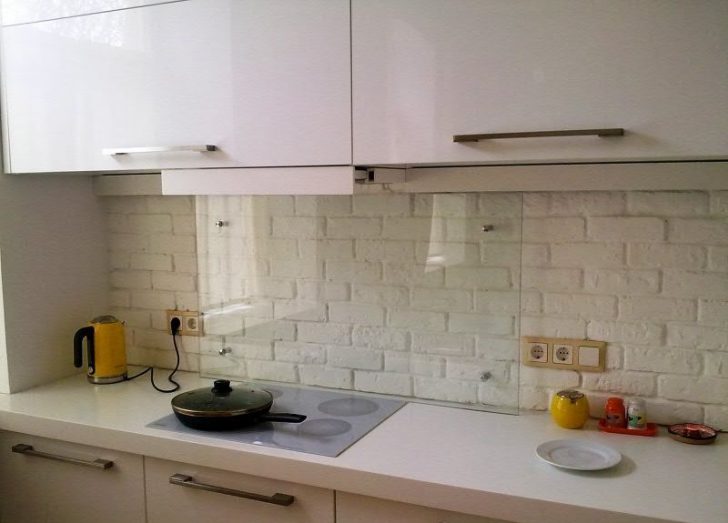
Only tempered glass is used for the apron
Tempered glass will feel great in the area of stove and hobs. He is not afraid of temperature tests.
Ordinary glass is not as reliable because it breaks easily.As for plexiglass, it is a very unsuitable option for decorating the working area. This type of finish will not withstand temperature extremes, it will quickly get scratched, and it is also difficult to clean off fatty contaminants.
Advice
To create a picturesque glass backsplash in the kitchen, discolored glass may be required. It is distinguished from the standard-produced counterpart by the absence of a pronounced “bottle” shade. On colored panels with landscapes, still lifes, urban motifs, the greenish background will be almost invisible, however, if the apron is designed mainly in white, then it will be impossible to do without Optiwhite.
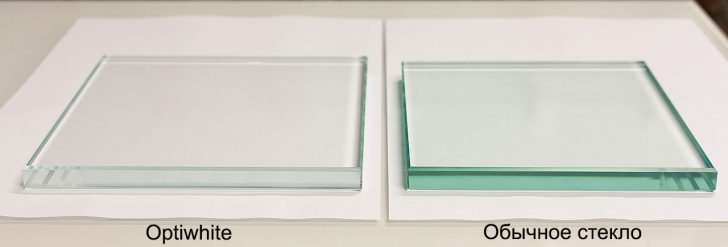
Optiwhite glass for backsplash
The high transparency of the glass will not only not spoil the idea, but also make the apron pattern as expressive and rich as possible. The cost of Optiwhite is 30 percent more than hardened, but the costs pay off with interest.
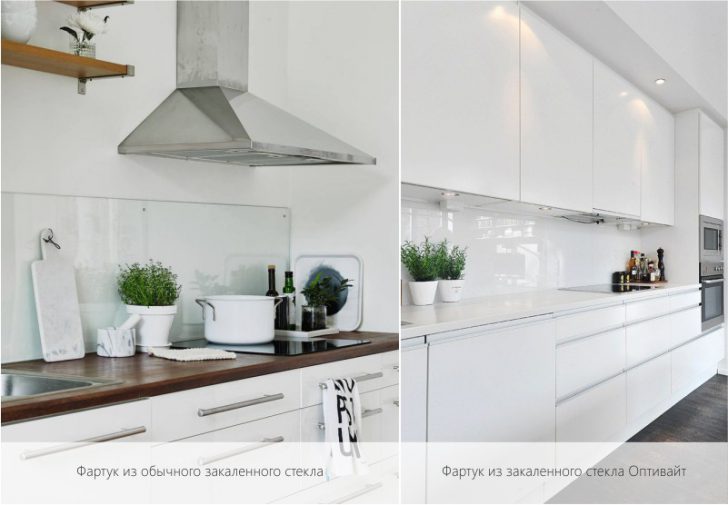
Optiwhite glass kitchen apron
How to make a glass apron
1. Colorless and no colorful pattern. To do this, you need a transparent or matte finish. The advantage of a transparent glass kitchen apron is invisibility. It literally melts into space. The main task of such a finish is to protect the area pasted over with photo wallpapers or painted walls from pollution. Frosted glass in this case looks more interesting. It doesn't give as much glare and can have a textured finish. The satin version is especially popular. Another popular solution is sandblasting* glass processing or silk-screen printing. These are methods that allow you to make inscriptions, transparent drawings and ornaments on the surface.
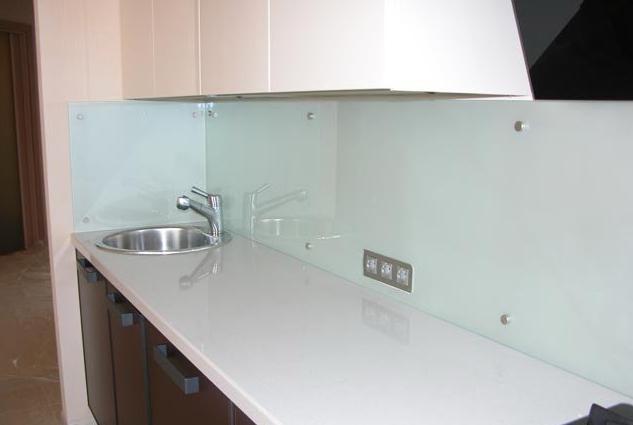
Frosted glass kitchen apron
2. With photo print finishing. Full-color UV printing allows you to apply incredibly colorful images to the surface of the panels. Today, this is the most favorite technique for decorating a kitchen space by designers. The apron turns out to be very attractive and ready to serve for many years. Pictures are printed from the back of the glass. The UV ink used in the work does not lose its brightness over time, does not spread when wet and does not crack even at a temperature of 120 °. A glass panel with a 3D image will look unusually impressive in the working area.
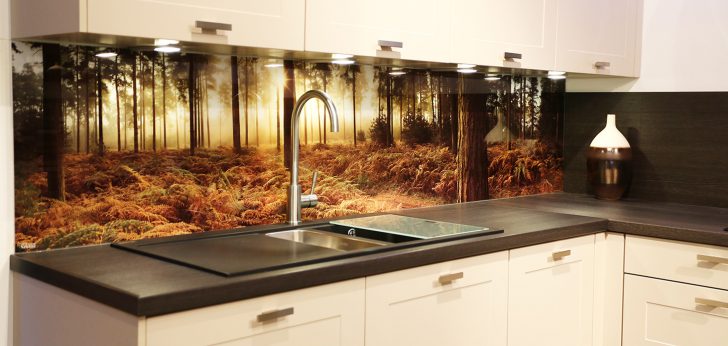
Apron for kitchen made of glass with 3D image
3. Painted. A glass apron painted in a single color in the kitchen is a stylish solution, often bright, but at the same time unobtrusive. The range of available tones is, without exaggeration, huge. Stemalite can be used to make it. The paint is passed along the “wrong side” of the panel, after which the glass is sent for heat treatment. This method of decorating glass guarantees its color durability.

Plain apron for the kitchen made of glass
4. Pasted over with vinyl film. This is a more budgetary way to apply an interesting pattern to a glass kitchen apron than photo printing. The film is also rolled on the back side of the panel. This will allow the glass to protect the decor from the unfavorable kitchen microclimate. When working with vinyl film, you need to try very hard to stick it with high quality, without bubbles and wrinkles. In this case, it will not flake off and crack.

Glass apron with vinyl film
5. Use triplex. This term refers to laminated glass. It varies in thickness. The advantage of this technology is that, in fact, a kind of glass sandwich is created, the filling of which is a colorful image.
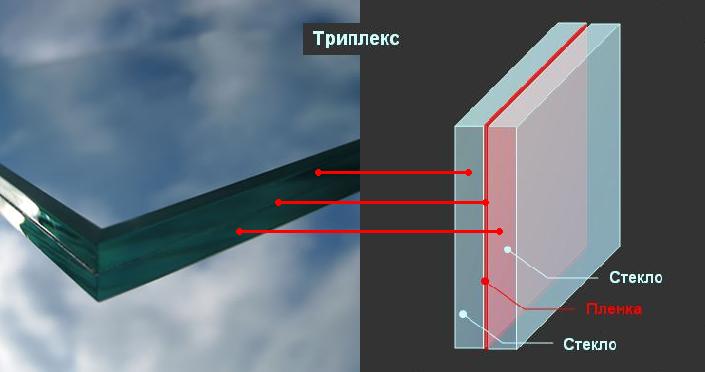
Triplex glass
Break triplex is almost impossible. The maximum that can happen to this "pie" is cracking. The apron is good in everything, but triplex is not a frequent guest in the kitchen. The reason for this is the high cost and the inability to process "for the place." Sockets and the roof rails can not be inserted into it.
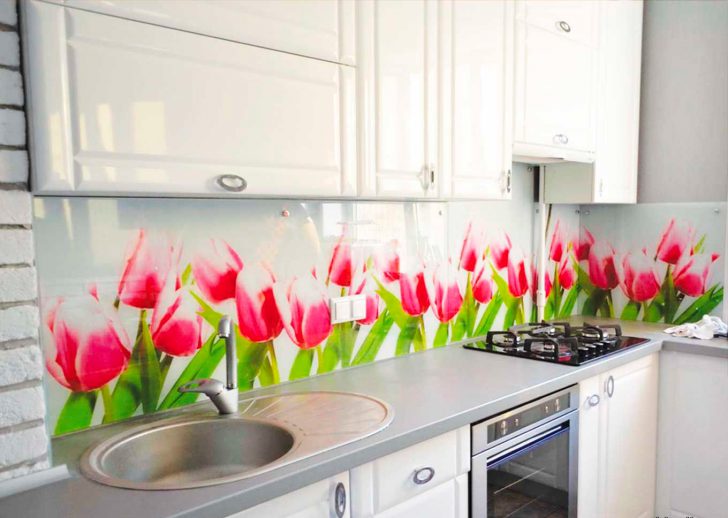
Triplex glass kitchen apron
6. Mirror. A glass apron in the kitchen in a mirror design is an unusual element. It erases spatial boundaries and creates the illusion of infinite spaciousness. Such a solution will appeal to expansive people who are ready to watch themselves doing any business, even such unsightly things as washing dishes, for example. This has become the main reason why in the decor of the working area, not full-length mirrors are often used, but mirror mosaics or tiles, the surface of which is sandblasted or partially matted.
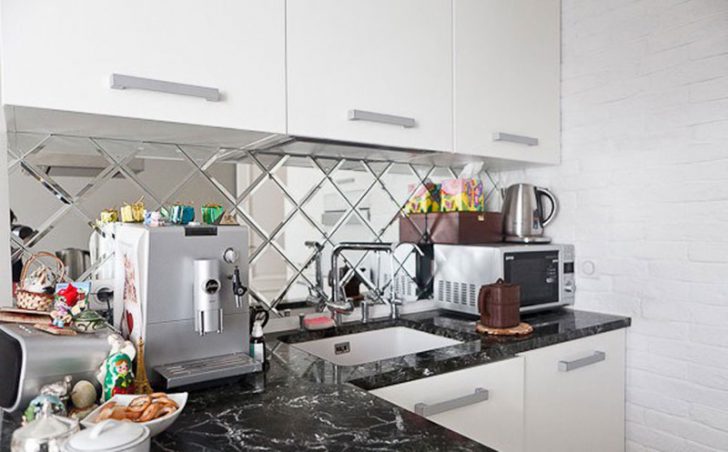
Mirror apron for the kitchen
Advice
An apron for a kitchen made of smooth glass is relevant for decorating small cramped rooms. The ability to unobtrusively reflect objects and the surrounding space allows you to create the illusion of the scale of the area. Glossy reflective surface, reflecting and scattering light fluxes, makes the interior light and bright.
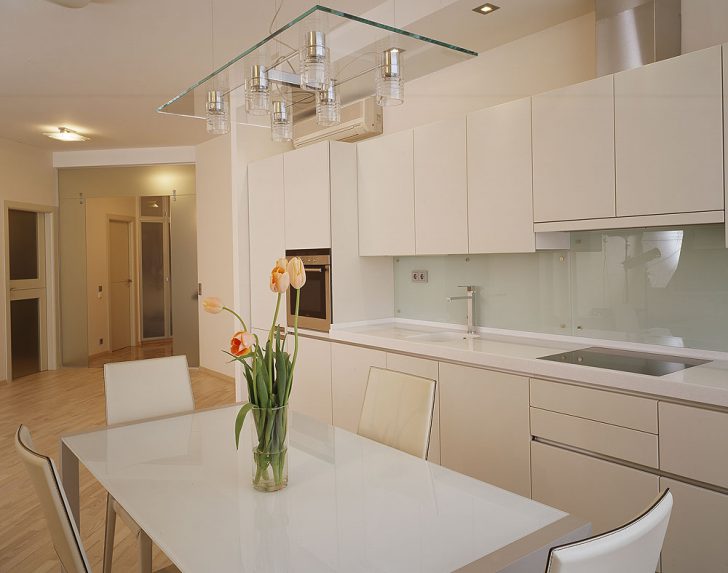
Glass apron will add light and lightness to the interior
To add perspective to a limited space, to make it deeper and deprive of borders, a picture with an urban plot will help.
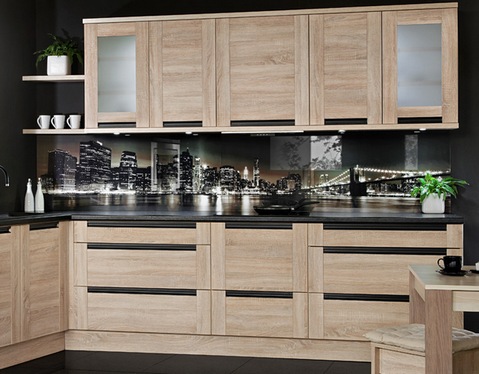
An urban backsplash adds depth to the space
Since the panels are made from high-strength material, you can not be afraid to use them in the smallest rooms. Even if they are subjected to frequent mechanical tests, their appearance, and hence the design of the kitchen as a whole, will not suffer.
back to index ↑Glass kitchen apron: installation subtleties
Making a working area with a glass apron does not take a lot of time. Its installation is carried out by experienced craftsmen in a couple of hours. The speed of installation and the absence of dirt favorably distinguishes work with glass panels from laying mosaics or tiles.
You can attach the apron to the wall in several ways:
1. Using fasteners.
This option is a priority, as it allows you to securely fix even panels of large weight and thickness. When choosing this method of fixing, there is no need to pre-prepare the wall for finishing. This refers to plastering and leveling work.
The use of fasteners makes it possible to dismantle the glass apron in the kitchen without problem, so that it can be easily removed for the duration of the current repair.
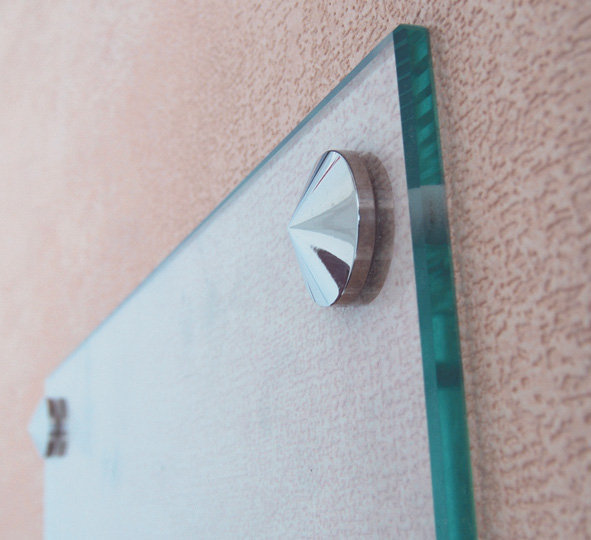
Fasteners for glass apron
The method of attaching the skinali can be hinged or through. Elements of hinged fasteners are in the form of centimeter-sized metal hook plates. The glass panel is simply inserted into them and clamped securely. The plates are hardly noticeable and do not spoil the overall impression of the decor. This method is especially relevant when installing an apron-puzzle, consisting of separate fragments.
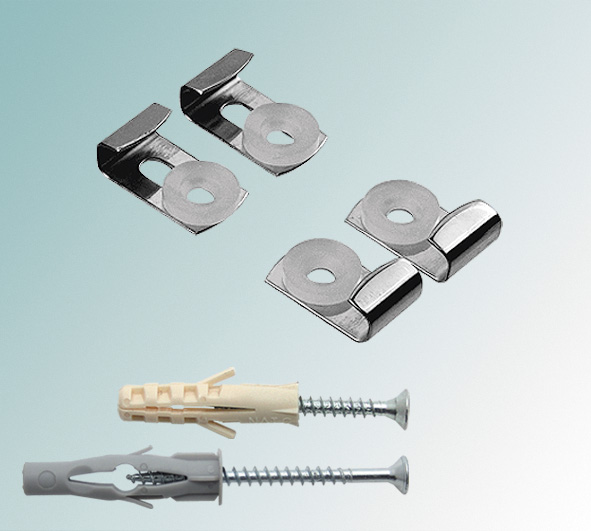
Hanging fasteners for an apron
If you plan to pass through the fastening method, then you need to drill holes for the screws in the apron for the glass kitchen even before it is hardened. Otherwise, it will be impossible to screw them. So that the fastener caps do not spoil the appearance of the panel, they are hidden under special caps.

Fastener for apron
The advantages of using metal fasteners are that they allow you not to prepare the wall surface for a new type of decoration at all. The apron can be installed directly on the tile that has lost its relevance or other existing finishes.
2. Applying liquid nails or other adhesives.
This method involves gluing the apron panel to the wall. Here it is important to properly prepare the area to be trimmed. The wall must be well aligned. Installation is carried out on a dry and dust-free surface. After installation, the butt part was skinned in the area of \u200b\u200bthe apron and the countertops are masked with a wall ledge.
It would seem easier to put a glass apron on glue: there is no need to drill walls and adjust fasteners, however, from the point of view of reliability, this method clearly loses. It is not suitable for massive panels.
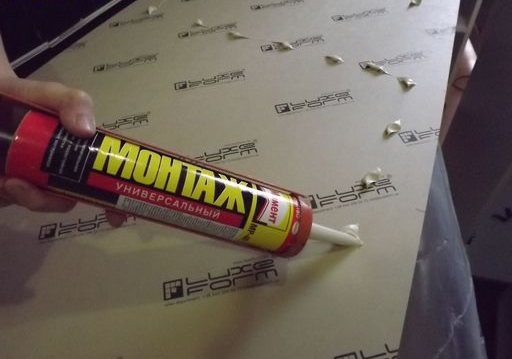
Installation of an apron on liquid nails
When assembling the decor from separate parts, the care of their joining is very important. It is necessary to mount a prefabricated apron for the kitchen from glass fragments so that there are no large gaps and cracks. Joints are sealed with silicone sealant. This will serve as a prevention of settling them with fungal colonies. The thinnest layer of insulator will not be noticeable with carefully performed work.
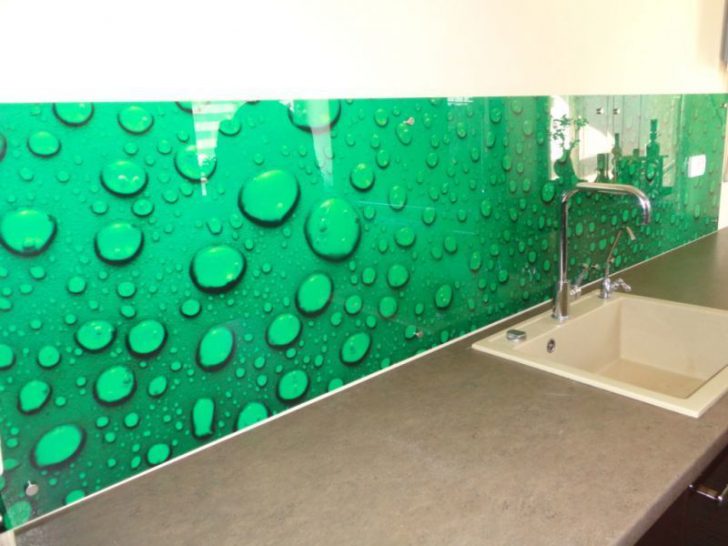
Treat the joints on the apron with sealant
If you plan to order installation from the manufacturer, then you should ask if the cost of services includes work on leveling the wall, installing fittings and additional accessories such as lighting, roof rails, skirting boards and more. If not, then these works will have to be done independently or paid extra for them on a separate account.
In principle, the installation of a glass apron in a standard kitchen with even walls that do not have ledges and niches (with experience in handling glass) is easy to do with your own hands.
back to index ↑Illuminated glass kitchen apron
Properly organized lighting will help to add additional attractiveness to the working area decorated with a glass apron. It is allowed mainly along the perimeter of the panel, less often it is equipped inside it. The source of light emission is an LED strip. Its power is enough to illuminate the surface of the skins and illuminate the countertops. LED strip can be:
1. White.
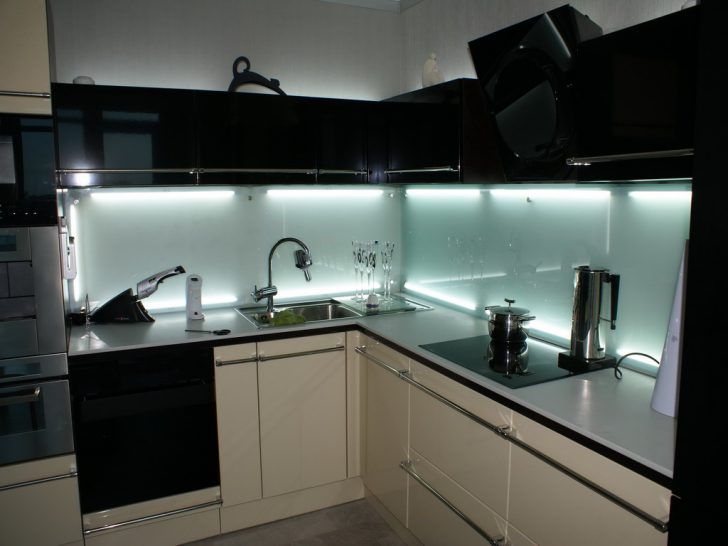
White apron lighting for the kitchen made of glass
2. Color (RGB).

Colored lighting for a glass kitchen apron
Color is more interesting for interior solutions, as it allows you to change the shades of the emitted light in accordance with the situation and mood.
On an apron for a glass kitchen, the backlight can be started from the end side or started from the back. In the first case, the tape is attached to the sides of the glass panel (more often along the long sides), hiding it in an aluminum profile of the OLIVET type, where channels are provided for embedding LED strips and wires. The profile is miniature and does not hurt the eyes. Moreover, its shape is thought out so that they can mask the attachment points of the apron.

Profile for OLIVET apron
From the colors available:
1. Champagne.
2. Gold.
3. Cognac.
4. Silver.
In the configuration of the profile there are seals with which you can close the joint of the countertop with the apron. This eliminates the need to purchase a special plinth. The solution for organizing the backlight is expensive, but whether it should be attributed to the disadvantages is a question.
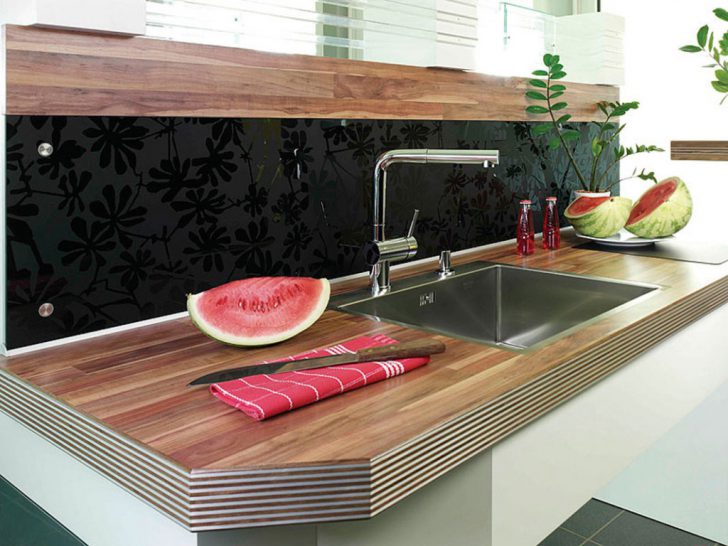
Sealant for apron and countertop joints
To organize lighting from the back, a glass apron in the kitchen must be installed at some distance from the wall. An LED strip is inserted into the resulting gap or niches are made in the wall for LED lamps. The complexity of this method lies in obtaining the effect of uniform illumination of skins with diffused light. The technology is cheap, but not loved by professionals because of the problems described above, although in terms of decoration it is in no way inferior to the first option.

LED backlight glass apron
Dimensions of the glass apron
In standard form, the panel can have a height in the range of 40 - 90 centimeters. There are restrictions on length. It can be made no more than 2.5 meters. To decorate large spaces, glass kitchen aprons are made prefabricated. Butt joints are easily masked, so that the surface is perceived as a whole.
How much does a glass apron cost
The price of the finished product depends on various factors:
1. Type of construction (solid or composite).
2. The type of glass used in the manufacture.
3. Decoration method.
4. Mounting options.
5. Installation difficulties (the presence of beveled corners, ledges, niches).
6. The need for additional design work.
You can make a preliminary calculation of the order using the calculator available on many websites of companies of this profile.Naturally, everything will be adjusted during the preparation of the application, but you can still get a rough idea of \u200b\u200bthe upcoming costs.

An example of an online calculator for calculating the cost of an apron for the kitchen
The most expensive glass aprons for the kitchen are made of Optiwhite and decorated with a 3D pattern.
Lead times vary from 10 to 15 days.
In addition to paying for panel manufacturing, many companies have a list of additional paid services, which include:
1. Trying on the product in place.
2. Color proofs.
3. Development of an individual layout.
4. Additional processing of the drawing by the designer.
5. Using a photo bank.
Almost all manufacturers advise applying additional protection to the apron in the form of a colored or colorless film. It should be clarified whether it is necessary to pay for this service or is it a bonus for the order.
Examples of how a glass apron might look in a kitchen interior can be seen in the photo galleries.
back to index ↑Let's summarize the information
"An apron for a kitchen made of any type of glass is not a cheap pleasure"
The glass used for the production of kitchen aprons goes through a tempering process, which gives it the required strength. It is impossible to cut such a product, therefore it is important to initially present the correct dimensions and indicate the installation locations for sockets and other accessories, including fasteners, if a through fixation option is intended. An apron for the kitchen of any type of glass is not a cheap pleasure. It is not worth the risk, saving on the departure of the measurer. In case of non-condition, you will have someone to make a claim.
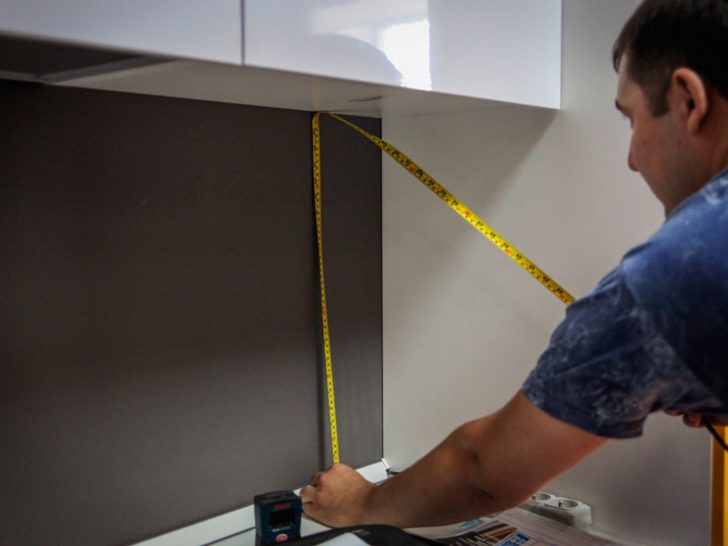
It is important to take measurements for the apron correctly
For those who are extremely important for the safety or durability of the finishing of the working area, there is an optimal solution to the issue in the form of a special type of glass - triplex. The layering of the product (as already mentioned, such an apron is assembled from two identical panels, between which the pattern is sealed) guarantees its double strength and complete protection of the decorative part.
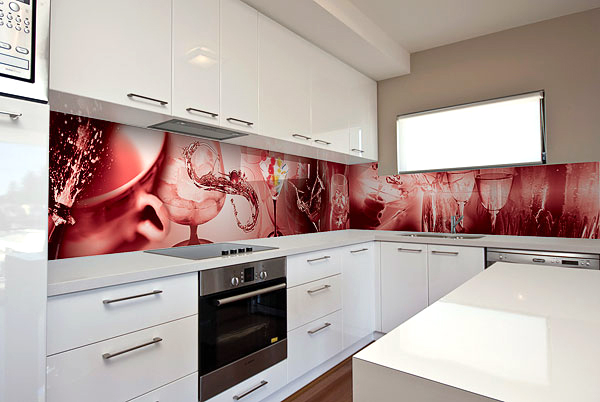
Triplex kitchen apron is particularly durable
When planning to order a glass apron for the kitchen, do not forget that the installation of an apron is not only its production. The concept includes the services of a measurer, the price of the material, the creation of a design layout, the cost of hardening and the decor method, the arrangement of the backlight, the application of a protective layer and, finally, delivery. When discussing the nuances of the transaction with the manager, it is necessary to clarify what is done from this list for a fee, so that at the final stage there are no “surprises” for an exorbitant surcharge.
back to index ↑Conclusion
A glass kitchen apron is the easiest way to make it practical and cozy. This is a magical element that can push walls apart and fill the space with a unique atmosphere. The original design of the working area can be a global step towards the kitchen of your dreams. Make it, and reality will exceed all expectations!
Photo gallery - glass kitchen apron
Video
